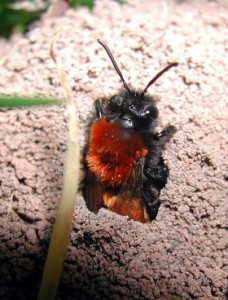
Bee feeding and pollinating

Butterfly feeding and collecting pollen
Insect pollinators are vital for fruit crops – from apples to blackberries – commercial and in the wild – and for our garden and wild flowers to set seed. Some fifteen hundred species of insects act as pollinators in the British Isles, including various bees, wasps, hoverflies, butterflies, moths and beetles. Most have suffered serious declines in numbers since the second world war; for instance, it is estimated that at least twenty of our native bee species have become extinct during this period! These declines are likely to be linked to changes in our landscape and patterns of land use since the 1940s. In early November 2014 the Department for Environment, Food & Rural Affairs launched its National Pollinator Strategy “to protect pollinating insects which support our food production and the diversity of our environment” – planned actions to reverse the decline of the last 70 years. If you have a garden or allotment you can help:
- Simply grow more flowers! Native species are best and plants which flower early and late in the season are particularly helpful to insects emerging from or preparing for hibernation.
- Leave at least one patch of your garden to grow wild. This might look a bit scruffy to you, but it will provide habitat for your pollinating insects to breed, lay eggs and raise their young.
- Cut your lawn less often and let the grass grow longer to allow nectar-rich plants such as clover to flower and feed pollinators.
-

Miner bee leaving nest burrow
Avoid disturbing places where pollinating insects may be nesting or hibernating. Most apart from honey bees live in the wild and hibernate or nest in holes in trees, walls, rotting wood or by burrowing into loose soil – careless garden tidying in winter can destroy next spring’s pollinators!
- Avoid using pesticides. Check your garden regularly so you can spot problems while they can be controlled by physical methods – hoeing; removing infected plants or parts of plants. If you have to use a pesticide keep quantity used and area covered to a minimum.
See the Bees’ Needs website for more on this topic.



